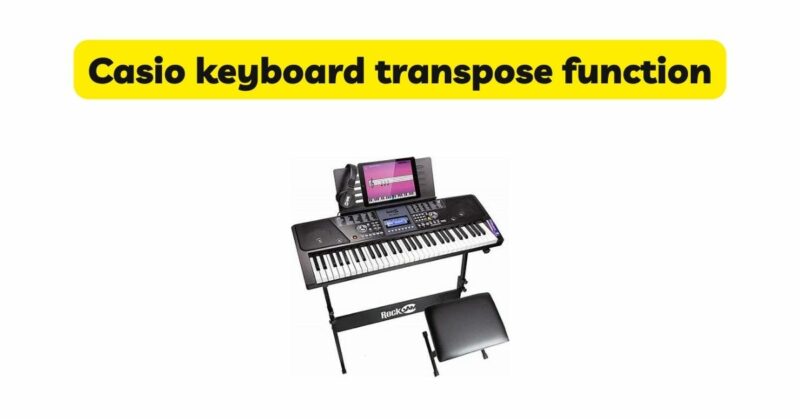The transpose function is a valuable tool found in Casio keyboards that allows musicians to effortlessly change the pitch of the instrument while maintaining the same finger positions. This feature is particularly useful for adapting a song to a different key, accommodating vocal ranges, or playing along with other musicians. In this article, we will delve into the details of Casio keyboard’s transpose function, exploring its functionality, practical applications, and advantages. By understanding how to effectively use this feature, musicians can expand their repertoire and enhance their musical performances.
- Understanding Transposition: Transposition refers to the process of changing the pitch of a musical piece without altering its musical intervals or relationships. Casio keyboards provide a transpose function that allows musicians to shift the entire keyboard’s pitch up or down by a specified number of semitones or steps. This means that the notes and chords played on the keyboard will sound higher or lower, depending on the selected transpose setting.
- Practical Applications: The transpose function offers a range of practical applications for musicians. Firstly, it enables adaptation of songs to different keys to match the vocal range of a singer or accommodate other instruments. For example, if a song is originally in the key of C but needs to be performed in a lower key such as B-flat, the transpose function can be used to shift the pitch of the keyboard down by two semitones, allowing the musician to play the same finger positions and achieve the desired key.
Secondly, the transpose function is helpful when playing along with other musicians who might be using instruments in different keys. By adjusting the transpose setting, the keyboard player can easily match their instrument’s pitch to stay in tune with the rest of the ensemble.
Lastly, the transpose function can be used as a creative tool during live performances or improvisations. By experimenting with different transpose settings, musicians can explore new musical possibilities and create unique arrangements of familiar songs.
- Accessing the Transpose Function: Casio keyboards typically feature a dedicated transpose button or menu option that allows easy access to the transposition feature. The specific method of accessing this function may vary depending on the model of the keyboard. However, it is generally a straightforward process that involves pressing the transpose button, selecting the desired transposition value using the keyboard’s display or buttons, and confirming the selection.
- Setting the Transpose Value: The transpose value represents the number of semitones or steps by which the keyboard’s pitch will be shifted. Casio keyboards typically provide a range of transposition values, usually spanning up to 12 semitones or one octave in both the upward and downward directions. The selected transposition value can be adjusted incrementally until the desired pitch change is achieved.
- Advantages of the Casio Transpose Function: The transpose function on Casio keyboards offers several advantages for musicians. Firstly, it provides a practical and efficient solution for adapting songs to different keys, eliminating the need to learn new finger positions or chord shapes for each key. This feature is particularly beneficial for beginners who may not be familiar with complex chord structures or scales in various keys.
Secondly, the transpose function allows musicians to quickly adjust their instrument’s pitch to match the vocal range of a singer or other instruments. This flexibility ensures that the music remains comfortable and accessible for all performers involved, resulting in a harmonious and cohesive performance.
Furthermore, the transpose function promotes creativity and exploration by enabling musicians to experiment with different tonalities and arrangements. By shifting the pitch, new musical ideas and interpretations can be discovered, offering fresh perspectives and opportunities for artistic expression.
- Limitations and Considerations: While the transpose function on Casio keyboards is a valuable tool, it is important to be aware of its limitations. Transposing a song to an extreme range, particularly beyond the available transposition range of the keyboard, may result in notes being played outside the instrument’s range or undesirable tonal characteristics. It is essential to choose appropriate transposition values that suit the instrument’s capabilities and the musical context.
Additionally, when using the transpose function, it is crucial to be mindful of the overall sound and balance of the music. Extreme transpositions can affect the timbre and clarity of the instrument, potentially compromising the quality of the performance. It is advisable to use the transpose feature judiciously and consider the overall musical arrangement and instrument combinations.
- Combining Transpose with Other Functions: Casio keyboards often offer various additional functions that can be used in conjunction with the transpose feature to further enhance musical performances. These functions may include accompaniment styles, rhythm patterns, layering multiple voices, and applying digital effects. Experimenting with different combinations of functions can add depth and richness to the sound while maintaining the desired transposition.
Conclusion: The transpose function on Casio keyboards provides musicians with a versatile and convenient tool for adapting music to different keys, accommodating vocal ranges, playing with other instruments, and exploring creative possibilities. By understanding how to effectively use the transpose feature, musicians can effortlessly shift the pitch of their instrument while maintaining the same finger positions, expanding their repertoire, and enhancing their musical performances. The Casio transpose function is a valuable asset for musicians of all levels, offering flexibility, adaptability, and endless opportunities for musical expression.

